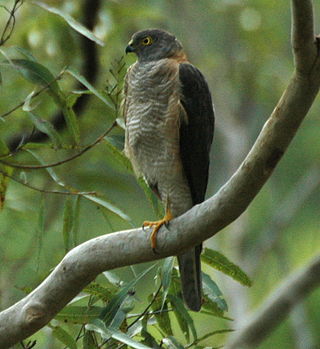
Mackerel is a common name applied to a number of different species of pelagic fish, mostly from the family Scombridae. They are found in both temperate and tropical seas, mostly living along the coast or offshore in the oceanic environment.

Herring are forage fish, mostly belonging to the family of Clupeidae.

The International Union for Conservation of Nature (IUCN) Red List of Threatened Species, also known as the IUCN Red List or Red Data Book, founded in 1964, is an inventory of the global conservation status and extinction risk of biological species. A series of Regional Red Lists are produced by countries and organizations, which assess the risk of extinction to species within a political management unit.

Accipiter is a genus of birds of prey in the family Accipitridae. With 49 recognized species it is the most diverse genus in its family. Most species are called goshawks or sparrowhawks, although almost all New World species are simply known as hawks. They can be anatomically distinguished from their relatives by the lack of a procoracoid foramen. Two small and aberrant species usually placed here do possess a large procoracoid foramen and are also distinct as regards DNA sequence. They may warrant separation in the old genus Hieraspiza.

Campylorhynchus is a genus of wrens, which has at least 15 described species. At 17–22 cm (6.8-8.7 in) long, these are the largest-bodied of wrens, including the largest species, the giant wren. Member species are found in South and Central America and in some cases, as far north as the southwestern United States.

A species that is extinct in the wild (EW) is one that has been categorized by the International Union for Conservation of Nature as known only by living members kept in captivity or as a naturalized population outside its historic range due to massive habitat loss.
This article is a list of biological species, subspecies, and evolutionary significant units that are known to have become extinct during the Holocene, the current geologic epoch, ordered by their known or approximate date of disappearance from oldest to most recent.
Metzia alba is a species of cyprinid in the genus Metzia. It inhabits Vietnam.
Metzia formosae is a species of cyprinid in the genus Metzia. It is considered "least concern" by the IUCN Red List. It inhabits small rivers in still or slow-moving waters and can be found in Yunnan, China and Taiwan.
Metzia lineata is a species of cyprinid fish. It inhabits medium-sized and small rivers of southern China, Taiwan, Laos, and Vietnam and is considered "least concern" by the IUCN Red List. It has a maximum standard length of 10.0 centimetres (3.9 in).

Endangered species, as classified by the International Union for Conservation of Nature (IUCN), are species which have been categorized as very likely to become extinct in their known native ranges in the near future. On the IUCN Red List, endangered is the second-most severe conservation status for wild populations in the IUCN's schema after critically endangered. In 2012, the IUCN Red List featured 3,079 animal and 2,655 plant species as endangered worldwide. The figures for 1998 were 1,102 and 1,197 respectively.






